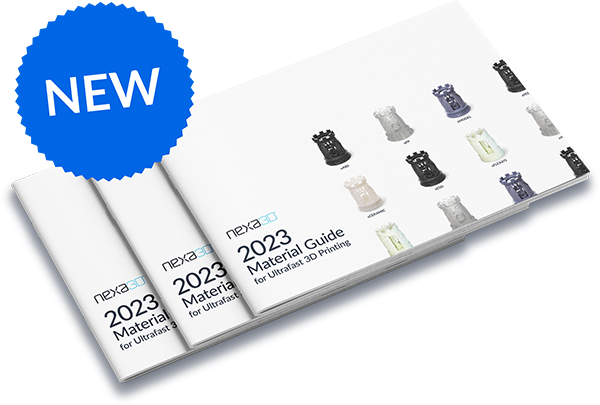- Metal 3D Printing Guide: What It Is & How It Works [2024] - February 5, 2024
- Metal Injection Molding: What It Is & Top Alternatives [2024] - January 11, 2024
- 11 Fastest 3D Printers on the Market (Industrial and Desktop) [2023] - December 11, 2023
New 3D printing methods and applications are being discovered daily, with industries adopting 3D printing for everything from human tissue to film props.
Originally designed to drastically reduce product development cycles, the earliest 3D printers weren’t overly concerned about cycle times. But today’s 3D printers are highly capable machines in terms of throughput, build volume, repeatability, and precision. They help accelerate product development, create better-quality prototypes, reduce operational costs – and fit right on your desk.
This comprehensive guide will explain what 3D printing is, how it works, the different types of 3D printers available, and their applications.
What is 3D Printing?
3D printing, also known as Additive Manufacturing (AM), refers to various processes of creating three-dimensional objects layer by layer using computer-aided designs (CAD).
In contrast to traditional subtractive manufacturing methods, 3D printing is an additive process. In subtractive manufacturing, parts are created by cutting away materials from a block until the desired shape is achieved. Additive manufacturing builds objects layer-by-layer, resulting in very little material waste.
Since its inception in the 1980s, 3D printing technology has rapidly evolved, transforming prototype creation and product manufacturing by shortening the design process and time to market.
How Does 3D Printing Technology Work?
After a design process, the 3D printing process begins with the loading of materials into the printer. Depending on the technology, some 3D printers use a laser to cure liquid resin into hardened plastic, while others fuse small particles of polymer powder at high temperatures to build parts. The most common 3D printing materials used are plastics, but metals, ceramics, and composites are all gaining popularity enabled by evolving technologies.
After the material is loaded, the 3D printer starts building the object layer-by-layer from the bottom up according to the instructions provided by the software. When all the layers have been printed, the object is complete.
After printing, the product must go through a post-processing stage before it can be used. It might require rinsing with solvents, removal of support structures, or sanding and painting. The 3D printing post-process may stabilize the mechanical properties of the object or improve its surface quality.
Once post-processing is complete, the product is ready for use.
3D Printing Materials
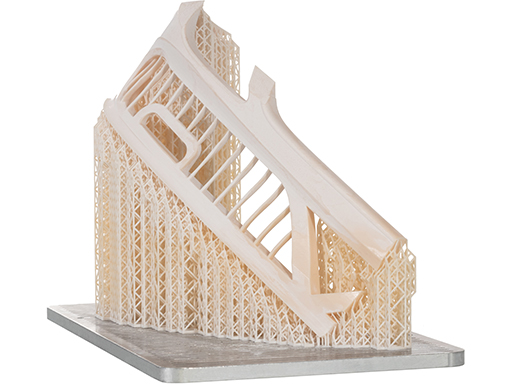
3D printing materials are as diverse as the applications of 3D printing technology. As such, the technology allows manufacturers to create products from various materials, including metals, plastics, ceramics, and resins.
Thermoplastics
The most popular 3D printing materials are thermoplastics. Thermoplastics are a type of material that becomes soft and moldable when heated and then returns to its solid form when cooled.
The most common types of thermoplastics used in 3D printing are acrylonitrile butadiene styrene (ABS), polycarbonate (PC), and polylactic acid (PLA). PLA is by far the most common material used because of its ease of use; it undergoes minimal expansion and contraction when heated and cooled.
Thermoplastics also include resin and filament materials. In FFF processing, many thermoplastic materials are available in filament form, and filament extruders are often used to fabricate filaments from thermoplastics.
Other materials include PET, Nylon, and PEEK. These materials, as well as ABS and PC, provide superior performance characteristics but come at the cost of being more expensive and difficult to print.
Photopolymers
Photopolymers are polymer materials whose qualities and properties change when exposed to a source light, commonly Ultraviolet (UV) rays. UV light causes a reaction that changes the photopolymer’s structure and alters its mechanical and chemical buildup.
Photopolymers are more versatile than other materials and can create objects that adhere to different specifications. Builders use them for various 3D printing processes, especially since the advent of Stereolithography (SLA) 3D technology. Acrylic and epoxy resins are common examples of photopolymer materials used in SLA 3D printing.
Metals
Metals are used in various industries because of their durability and strength. The process of 3D printing metal is quite different from other materials. It involves using a high-powered laser to melt the metal powder into the desired shape (a process called DMLS).
There are various metal melting technologies including powder bed fusion, direct energy deposition, material extrusion, and binder jetting. Material extrusion and binder jetting required additional debinding and sintering to produce finished parts.
The most common metals used for 3D printing are aluminum, stainless steel, bronze, and titanium. These materials are often used for creating prototypes and functional parts for end-use applications. The biggest hurdles for metal 3D printing are very high costs and low dimensional accuracy of metal 3D printing – often requiring secondary machining to achieve the required tolerances.
Composites
Composite materials are often made up of two or more different materials, which, when combined, have properties different from their original materials. In 3D printing, composite materials are usually a combination of a thermoplastic base material and other reinforcing elements like nylon, carbon fiber, fiberglass, kevlar, or graphene.
Composites are very common in the FDM 3D printing space as base thermoplastics. They often range from commodity materials like Acrylonitrile Butadiene Styrene (ABS) and PolyLactic Acid (PLA) to other high-performance polymers like PEEK. In SLS 3D printing, builders use nylon as a common material for composite SLS powders.
Powders
Powders are somewhat of a 3D printing material subcategory since they are typically made up of either metals or thermoplastics. This 3D printing material can be used to create products from various materials, including metals, plastics, and ceramics. The 3D printer melts the powder by melting or spraying a liquid binder evenly across the build platform until the desired thickness is achieved.
The most common powder materials used for 3D printing are Polyamide and Alumide. Polyamide allows a high level of detail and is often used for joints and interlocking parts. For example, the PA11 and PA12 nylons have strong chemical resistance, excellent resolution, and can recycle more than 50% of unfused powder after a build.
Alumide, on the other hand, is a mixture of polyamide and gray aluminum powder. It’s often used for creating functional parts and products with a metallic finish.
Learn more in our guide to the latest ultrafast 3D printing materials in 2023.
Types of 3D Printing
There are several types of 3D printing processes. They include:
1. Material Extrusion
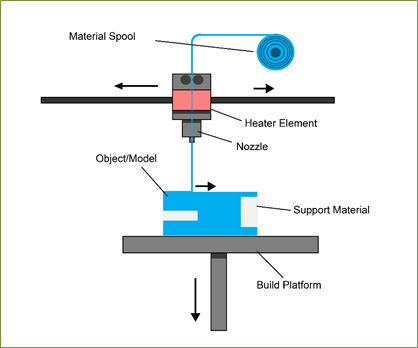
What it is:
Material extrusion is a 3D printing technology that uses a continuous material filament to create objects. The process begins with the material, typically plastic filament, being fed through a heated nozzle. The nozzle melts the material and deposits it onto the build platform.
The deposition process is controlled by a computer-aided design (CAD) file, which dictates the path of the extruded filament. The object is then built layer by layer until it is complete.
Material extrusion is commonly known as fused deposition modeling (FDM) or fused filament fabrication (FFF). FDM technology is best for creating large parts with simple geometries from various materials.
Material Extrusion Benefits:
- Material extrusion is a relatively simple process that can be used with various materials, including metals, plastics, and composites.
- Material extrusion is also relatively more cost-effective.
- Relatively minimal post-processing is required.
2. Vat Photopolymerization / Resin 3D Printers
Vat photopolymerization is an additive manufacturing technique that produces 3D objects by selectively curing photopolymer liquid resin through light-activated polymerization. The build platform is lowered into, or raised out of, a vat of liquid photopolymer resin during this process.
The object is created by projecting light or a laser onto the build platform, which causes the photopolymer to solidify and adhere to the platform. After each layer is cured, the build platform is lowered or raised slightly, and a new photopolymer layer is introduced. This process is repeated until the object is complete.
Resin 3D printers are now available in three generations. The first generation, Stereolithography (SLA) uses a laser to draw out each layer, the second, Digital Light Processing (DLP) uses a projector chip to project a full layer of curing light, and the third, Masked Stereolithography (mSLA), uses an LCD panel to project a full layer of curing light.
Stereolithography
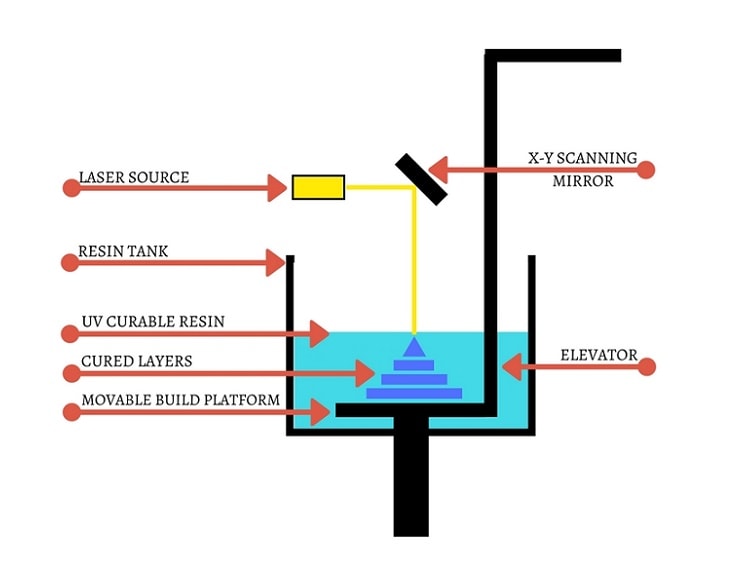
What it is:
Stereolithography (SLA) is an additive manufacturing technology that uses a laser to cure photosensitive materials, layer by layer, to create 3D objects. This is a popular resin 3D printing process that has become widely accepted because of its ability to use various materials to produce accurate, isotropic prototypes and end-use parts with fine features and smooth surface finish.
SLA machines work with the principle of using a light source (UV laser or projector) to cure liquid resin into hardened plastic. SLA machines can be physically identified through their core components, like the light source, the build platform, and the resin tank.
Best for:
SLA technology is best for highly-detailed prototypes requiring watertight tolerances and smooth surfaces like molds, patterns, and functional parts.
Digital Light Processing
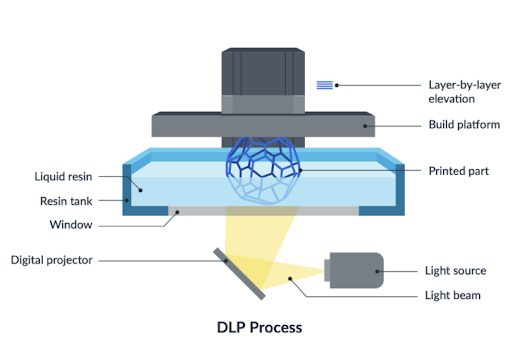
What it is:
Digital Light Processing (DLP) uses a liquid resin and an LCD screen or projector to display the images of each layer which then cures when exposed to ultraviolet light. The projector flashes an image of an entire cross-section, thereby printing a whole layer at once. This ensures faster printing speeds and represents a major upgrade from the traditional SLA 3D printers.
However, Digital Light Processing does not accurately solve the classic speed vs quality issues that existed in the predecessor SLA 3D printers. Ordinarily, the print speed is not affected by the number of parts on a build plate, but it may affect the quality of the parts because the limited number of pixels gets distributed within the number of parts.
Another potential challenge with DLP is that its single projection source means that the image can become distorted, which can lead to uneven build quality.
Best for:
DLP technology is best for creating high-resolution parts with smooth surfaces.
Masked Stereolithography
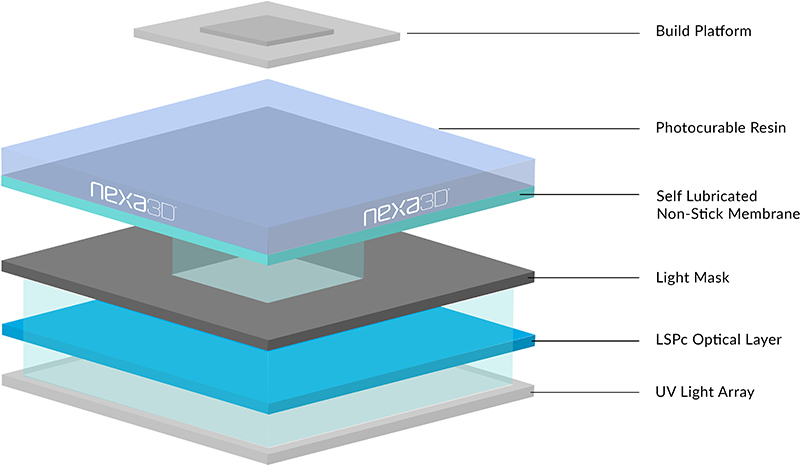
Nexa3D’s LSPc technology.
What it is:
The mSLA uses an LED array light source rather than a laser or a single projection point. This LED array projects light through an LCD panel, which masks the necessary pixels while printing and allows only the necessary pixels to pass light. As a result, curing occurs only in the unmasked section.
Nexa3D’s resin 3D printers use a proprietary version of mSLA technology called Lubricant Sublayer Photo-curing (LSPc). While mSLA itself is one of the fastest technologies – using an LCD light engine to project UV light across the build platform to cure a full layer of the print at once – LSPc goes a step further. This technology combines a UV light array and LSPc Optical lens layer to ensure light uniformity in this process, which is essential for optimal use of LSPc High Contrast Mask.
The LSPc HC Mask is in charge of projecting 3D image slices onto the vat where the photopolymerization process takes place layer by layer. This provides the fastest printer on the market with the largest build area in its class without sacrificing image quality: you get high edge-to-edge performance with no distortion, as in the case of DLP 3D printers.
Best for:
mSLA 3D printers have a high resolution, resulting in parts with a smooth surface finish. This allows them to work in a broader range of industries including dentistry, automotive, jewelry, and manufacturing. Stereolithography in general is best for creating smooth surfaces with high accuracy and detail.
Vat Photopolymerization Benefits
- High resolution and dimensional accuracy
- Variety of material options
- Relatively low cost
- High speed/throughput
3. Powder Bed Fusion
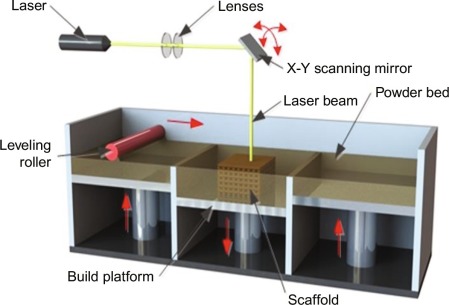
In powder bed fusion, a laser or an electron beam selectively melts the powder material layer by layer. The process begins with a layer of powder spread evenly over the build platform and then the laser or electron beam fuses the powder to form the desired shape. The build platform is lowered, and another layer of powder is spread over it.
The most common type of powder bed fusion is selective laser sintering (SLS).
Selective laser sintering
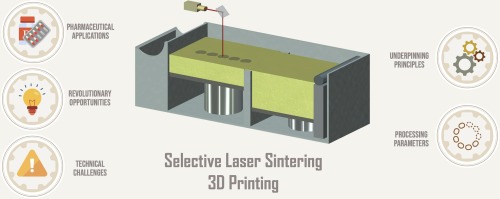
What it is:
Selective Laser Sintering (SLS) is an additive manufacturing technology that uses a laser to fuse small particles of plastic, metal, ceramic, or glass powders into a solid object. In sintering, the powder is heated below its melting point which causes the particles to bond without changing the object’s overall shape. In melting, the powder is heated above its melting point, which allows it to flow and take on the desired shape.
Powered by Quantum Laser Sintering technology, Nexa3D’s QLS 820 delivers premium production capabilities with incredible speed, end-to-end traceability, centralized printer management, real-time data monitoring, and the highest throughput in its class.
The QLS 820 is about 60% faster than the existing industry standard with double the average packing density.
Best for:
Selective Laser Sintering is best for creating functional parts and prototypes with complex geometries from various materials.
Powder Bed Fusion Benefits
- Complex geometries with little to no support structures.
- Production of multiple parts simultaneously, saving time and money.
- High levels of accuracy and repeatability.
- Produces production quality parts
4. Binder Jetting
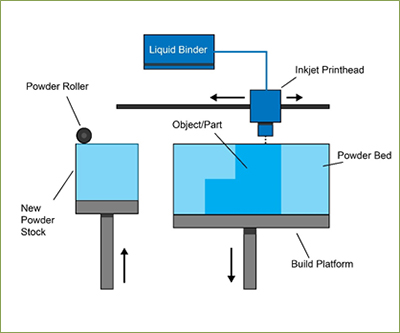
Binder jetting deposits a liquid binder onto a powder bed to join the particles and create the desired shape. The process begins with a layer of powder spread evenly over the build platform. The print head moves over the powder bed and selectively deposits the binder onto the powder. The binder binds the particles together and creates the desired shape.
After the binder is deposited, the build platform is lowered, and another layer of powder is spread over it. The process is then repeated until the object is complete. Depending on the material, the part may then go into a debind/sintering oven as is the case with metal before the part reaches its final performance specs. The most common type of binder jetting is selective deposition modeling (SDM).
Binder Jetting Benefits:
- Used with various materials, including metals, ceramics, and plastics.
- Provides high levels of accuracy and repeatability.
5. Material Jetting
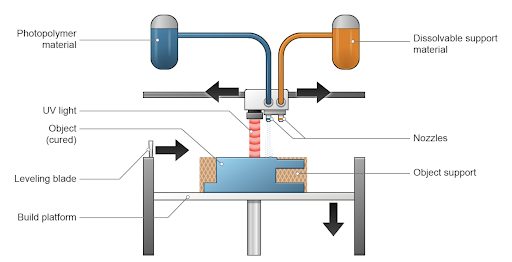
Material Jetting (MJ) 3D printing works in the same way as a 2D printer. A printhead (similar to the printheads used in regular inkjet printing) dispenses droplets of a photosensitive polymer material that solidifies under ultraviolet (UV) light. This technology dispenses viscous liquids to create wax-like parts which have applications in investment casting.
Material jetting parts have high dimensional accuracy and a smooth surface finish. Multi-material printing is possible, and it’s compatible with a wide range of materials, including ABS-like, rubber-like, and fully transparent materials.
Material Jetting Benefits:
- Material jetting provides high print accuracy and speed in multi-color, multi-material parts.
- Best for injection molding, casting patterns, and visual or haptic prototypes.
6. Direct Energy Deposition
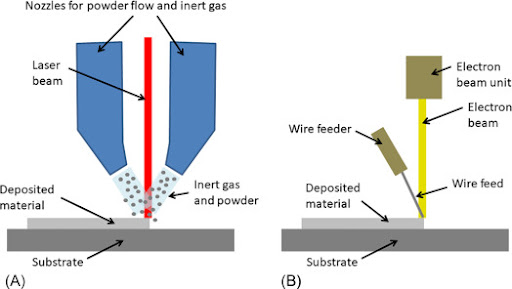
Direct energy deposition adopts the same principle as powder bed fusion, but instead of fusing material on an existing bed of powder, the powder (or in other cases wire) is simultaneously fed through the nozzle and fused by a laser, electron beam, or plasma jet.
The print head then selectively applies energy to the powder or wire to melt and deposit it onto the build platform.
Direct Energy Deposit Benefits:
- Direct energy deposition has a higher deposition rate which allows for a faster production rate making it ideal for large metal objects such as rocket nozzles.
- This technology is often used to repair or enhance existing objects.
7. Sheet Lamination
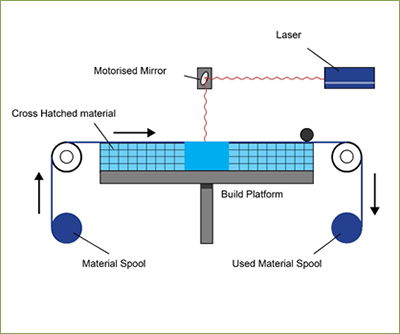
Sheet lamination technology builds objects by bonding together layers of flat sheets. The process begins with a stack of flat sheets placed on the build platform. The print head then selectively applies adhesive to the sheets and bonds them together. The build platform is then lowered, and another layer of sheets is placed on top.
Sheet lamination 3D printing often uses Laminated Object Manufacturing (LOM) and Ultrasonic Additive Manufacturing (UAM). The former involves using alternate layers of material and adhesive to produce items with visual and aesthetic appeal, while UAM employs ultrasonic vibrations to weld layers of material together.
Sheet Lamination Benefits:
- Suitable for creating large objects.
- Quick cutting speeds.
The 3D printing process
3D printing technology is constantly evolving and the 3D printing process varies according to the exact technology and software used. But, most 3D printing follows these steps:
1. Project Planning & Designing
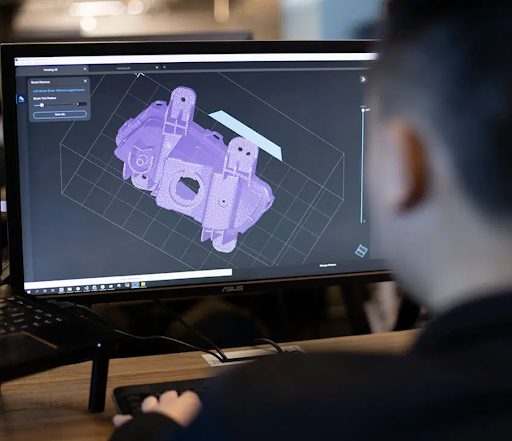
Nexa3D’s NexaX software.
The planning stage involves deciding what parts are best suited for additive manufacturing and designing the parts accordingly. Designers and engineers often ask the following questions:
- How quickly can the parts be made?
- What will the quality be?
- How much will they cost?
Then, they design a 3D model or CAD file.
The CAD model is imported into a slicing software that specifies print settings, and “slices” the digital model into layers representing the part’s horizontal cross-sections. Adjustable printing settings on the 3D printer include orientation, layer height, support structures, and more.
After the design setup is complete, the software sends the instructions to the 3D printer via a wireless, USB thumb drive, or wired connection.
While there are a number of open-source software platforms that enable the masses of hobbyist resin 3D printers, they tend to require in-depth knowledge to dial in parameters for your specific 3D printer. Fortunately, most OEMs will supply homegrown software, such as NexaX.
2. Choosing Materials
The next stage after deciding to 3D print your parts is selecting the most appropriate materials and machines for the job. The combination of material and printer depends on various factors, including the final product’s desired strength, flexibility, durability, and heat tolerance.
3. Printing Preparation
Printing preparation involves packing the build plate, orienting and stacking parts, slicing thousands of layers, generating supports, simulating and validating the build process, and then creating the file for the 3D printer.
The best 3D printing software automates as much of the build process as possible, from material recommendations to part orientation and support generation. The NexaX print preparation software quickly auto-generates supports and helps users validate their build processes before committing to print.
4. The Printing Process
The 3D printing process depends on what AM technology is being used. Whether it’s sheet lamination, DLP, or SLS, the 3D printer gets to work creating three-dimensional objects layer by layer using CAD files.
5. Post-processing
After the printing process is complete, it’s time for a powerful, consistent, and sustainable washing solution. Curing is the process of hardening a material after it has been printed. This creates consistent dimensional accuracy, robust structural integrity, and stronger molecular structures.
Like the actual printing, post-processing varies based on the 3D technology used. For example, in SLA post-processing, curing is done by exposing the product to either heat, UV light, or a combination in a controlled chamber. For extrusion and powder-based 3D printing, post-processing can include manual sanding and finishing, depending on the quality of the print.
Great post-processing systems should ensure consistent process controls and workflows – no matter the size or complexity of parts. An advanced 3D printer should have an automatic self-contained device that accepts the build plate from the printer and cleans the printed parts.
For instance, Nexa3D printers come with the xWash and xCure tools which allows operators to move an entire job from the 3D printer to the wash station in seconds.
Applications and Examples of 3D Printing
Many industries continue to adopt 3D printing for different applications. Some prominent examples and use cases of 3D printing technology include:
1. Medical Devices
Additive manufacturing is making a mark on the medical industry by 3D printing custom prosthetics, implants, and body parts. 3D technology is used to create personalized medical devices such as hearing aids, braces, and even dentures that fit perfectly.
For example, the company WeMed designs telemedicine devices. After discovering the need for remote diagnostic medical devices, WeMed partnered with Nexa3D to manufacture the SKOP™ 3D printed stethoscope. Using 3D printing to create the cardiopulmonary auscultation medical device allowed it to be both accessible and affordable.
3D printers are also ideal for dental models, splints, impression trays, occlusal night guards, and more. For example, Nexa3D’s NXD 200Pro was designed specifically for the dental industry and offers world-class dental model manufacturing capabilities at ultrafast speeds, with a large build plate to create up to 20 flat 3D-printed dental models in less than 30 minutes.
2. Industrial Manufacturing
3D printing technology is used to create prototype parts and improve production cycles in industrial manufacturing. The additive process reduces waste and the need for large spare part inventories. Shorter production times also mean that industrial manufacturers can quickly respond to customer demands and produce customized products.
Organizations can also conduct hybrid manufacturing: the use of 3D printing as well as traditional manufacturing technologies to create a part. Traditional processes can be made more agile and flexible by using 3D printing, offering the potential to reduce costs and improve an organization’s economies of scale.
3. Automotive, Rail, and Aviation Industries
The auto, rail, and aviation industries use 3D printing technology to create lightweight parts and develop prototypes for new designs, helping save time and money during the development process.
The rail industry uses 3D printing technology to address spare part obsolescence issues by producing on-demand tools. Railway companies are adopting toolless production backed by 3D printing to significantly cut the manufacturing time for obsolete spare parts, in some cases by as much as 95%.
Williams Racing F1 is another great example of 3D innovation in the auto industry. The company uses Nexa3D’s NXE400 3D printer for its cutting-edge innovation and testing operations.
Through NXE400’s ultrafast printing, Williams F1 achieves rapid iteration to facilitate a swift print/check/modify/print/repeat cycle. This ultimately allows for a more standard level of refinement that would ordinarily be impossible in their limited timeframe.
The aerospace sector also uses additive manufacturing to create parts for satellites, rockets, and aircraft. As airplanes are expensive investments, additive manufacturing is ideal for minor maintenance and repairs, especially for missing or damaged non-essential components for the airplane interiors, such as air ducts, tray tables, window shades, and so on.
4. Engineering and Product Design
3D printing technology allows designers to visualize their designs and create photo-realistic renditions of products before they are manufactured. Even better, with 3D visualization technology, product designers can go beyond the limitation of photos and create full-color, moving images of their products.
In addition, engineers are using 3D printing technology to create prototypes for testing and experimentation. The ability to quickly produce prototypes helps engineers save time and money during the product development process.
5. Construction
3D construction is an exciting new application of 3D printing technology that is being used to build homes, office buildings, and other structures. The technology offers several advantages over traditional construction methods, including printing custom designs, using recycled materials, and constructing buildings in remote locations.
3D printers can now print entire homes, including walls, floors, and roofs. The technology also creates concrete molds that can be used to construct buildings quickly and efficiently. Also, 3D construction is less labor-intensive than traditional construction methods, reducing construction project costs.
A perfect example is the world’s first 3D-printed commercial building, the Dubai Future Foundation (DFF). The 250 sqm office building was printed using a 20m x 40m concrete printer in just 17 days, costing less than $100,000.
6. Consumer Products
Furniture, eyewear, home decor, jewelry, and more are all being created by 3D printing. The technology offers several advantages for manufacturers, including the ability to create intricate designs, material recycling, and time-saving.
As other industries continue to explore the potential of 3D printing technology, the applications of the technology are expected to grow exponentially.
Use the Best 3D Printer on the Market Today
The 3D printing industry has gone from huge machines taking days to make a single product to professional-grade 3D printers that take you from CADs to parts in less than 30 minutes. From medical devices to airplane parts, 3D printing is changing the capabilities of different industries every day.
Nexa3D’s 3D printers, which use its patented Lubricant Sublayer Photo-curing (LSPc) technology, achieve the fastest printing speeds and highest throughput in their class. From the XiP to the NXE series, the Nexa3D 3D printers are known for their groundbreaking combination of speed and quality.
Request a free sample part to experience the capabilities of ultrafast 3D printing.
